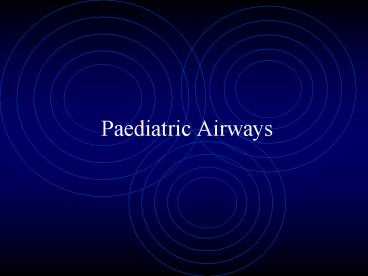Paediatric Airways - PowerPoint PPT Presentation
1 / 19
Title: Paediatric Airways
1
Paediatric Airways
2
Upper Airway Anatomy
- Large head
- Large tongue
- High anterior larynx
- Infant epiglottis long, floppy U shaped
- Funnel shaped larynx
- Narrow trachea
3
Airway Differences
4
5
(No Transcript)
6
(No Transcript)
7
Respiratory Physiology
- Not mature until 8 years
- Deadspace volume very small
- Higher airflow resistance
- Higher chest wall compliance
- Higher ventilation-perfusion mismatch
- Higher oxygen consumption for weight
- Infant diaphragms lack slow muscle fibres
- Decreased respiratory reserve
8
- Area difference 12 fold prior to pathology
- Flow difference 120 fold prior to pathology
- Flow ? r 4 400 fold following pathology
9
Down Syndrome
- Relatively large tongue
- Small mandible
- Possible Cx spine instability
- OSA is common
- Possibly smaller ETT
- Difficult intubation
10
Pierre Robin Syndrome
11
URTI
- Bronchospasm
- Mucous plugging
- ? Early pneumonia
- Laryngospasm
- Stridor
- Cough
12
Tracheal Intubation
- Airway protection
- Facilitates access to shared airway
- Muscle relaxation
- Improve efficiency of ventilation
- Long procedures
13
ETT
- Diameter
- Oral ETT age/4 4
- Neonate 3.0-3.5mm
- Nasal under 6 years same, over 6 years half to
one size smaller - Length
- Oral ETT age/2 12
- Nasal ETT age/2 15
14
Cuffed ETT ?
- Postintubation croup?
- Recent studies little difference
- 2-3 cuffed or uncuffed post surgery
- 15 cuffed or uncuffed post PICU
- Less need to replace tube
- Better airway protection ? relevance
- No gas leak good for staff and IPPV
- Smaller diameter tube higher resistance
15
LMA
- As a face mask alternative
- Not with potential full stomach
- Possible for some dental/ENT work with minimal
expected soiling - Anaesthetist preference
16
Face Masks
17
Laryngeal Spasm
- Avoid
- CPAP Oxygen
- Clear airway judiciously
- Deepen anaesthesia
- Topical lignocaine
- Very low dose Sux (¼ usual)
- Intubate/reintubate if needed
18
Difficult Intubation
- AVOID
- Refer to tertiary centre if possible
- Spontaneous ventilation gas induction
- Then???
19
- Shikani































